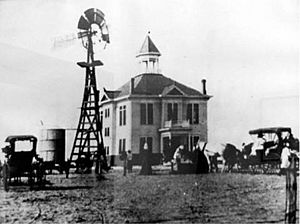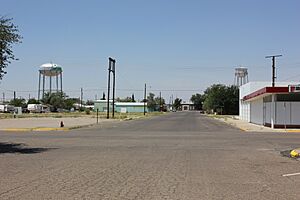Kermit, Texas facts for kids
Quick facts for kids
Kermit, Texas
|
|
|---|---|
|
City
|
|
| City of Kermit | |
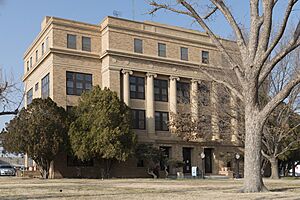
Winkler County Courthouse in Kermit
|
|
| Nickname(s):
K-Town
|
|
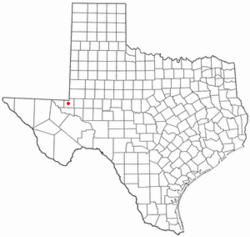
Location of Kermit, Texas
|
|
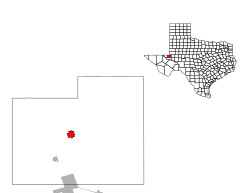 |
|
| Country | United States |
| State | Texas |
| County | Winkler |
| Incorporated | 1938 |
| Area | |
| • Total | 2.52 sq mi (6.52 km2) |
| • Land | 2.52 sq mi (6.52 km2) |
| • Water | 0.00 sq mi (0.00 km2) |
| Elevation | 2,861 ft (872 m) |
| Population
(2020)
|
|
| • Total | 6,267 |
| • Density | 2,486.90/sq mi (995.26/km2) |
| Time zone | UTC−6 (Central (CST)) |
| • Summer (DST) | UTC−5 (CDT) |
| ZIP code |
79745
|
| Area code(s) | 432 |
| FIPS code | 48-39004 |
| GNIS feature ID | 1360598 |
Kermit is a city in Texas, USA. It's also the main town, or 'county seat,' of Winkler County. In 2020, about 6,267 people lived there. The city was named after Kermit Roosevelt. His father, President Theodore Roosevelt, had visited the county before the town was named.
Contents
History of Kermit, Texas
How Kermit Started
Kermit began as a place where nearby ranches could get supplies. It became the main town of Winkler County in 1910. The first public school and post office opened that same year.
The town is named after Kermit Roosevelt. He once visited the T Bar Ranch in Winkler County to hunt antelope. This was just a few months before the town got its name.
In 1916, the county had a very bad drought. Many farmers and ranchers had to leave. By 1924, only one family, the Ern Bairds, remained in the town. Only one student went to school in the whole county for five months that year. By 1926, only three houses and the courthouse were still in use.
Oil Discovery and Growth
On July 16, 1926, everything changed. Oil was found in the Hendrick oilfield, close to Kermit. This discovery caused the town to grow very quickly, which is called a "boom."
In 1927, about 1,000 people lived in Kermit. By 1929, that number grew to 1,500. A railway, the Texas-New Mexico Railway, reached the town on March 4, 1929.
Kermit During the Great Depression
The Great Depression didn't affect Kermit as much as other places in the 1930s. However, the population did drop in the early 1930s. By the end of the 1930s, things improved. The population grew to 2,700 people, and there were 180 businesses.
On February 15, 1938, residents voted to officially make Kermit a city. During the 1940s, the oil boom made land prices double. There weren't enough houses, so some people even lived in tents. A bank opened by 1945. The elementary school had to be made bigger, and a hospital was built.
Kermit's Oil Boom Days
Kermit kept growing in the 1950s, and new housing areas were built. By 1960, the city had 10,465 people and 260 businesses. It was estimated to grow even more, to over 12,000 people, during that decade.
Flooding became a problem because the land was very flat. So, new streets were built to help with the flooding. More housing additions were also constructed. In 1966, the town moved the last working wooden oil derrick from Loving County to Pioneer Park in Kermit. This was a symbol of how important the oil industry was to Kermit and Winkler County.
In the 1970s and 1980s, Kermit's population went up and down, between 8,500 and 6,912. The number of businesses also changed, from 200 to 116. The city improved its services, and more housing was built.
On June 3, 1980, a large sinkhole appeared on a property. It started as 9 feet wide and grew bigger. Within four days, it became a tourist attraction. It was about 400 feet long, 200 feet wide, and 30 feet deep. In 1990, the population of Kermit was 6,875.
Geography and Climate
Kermit is located at 31°51′14″N 103°5′32″W / 31.85389°N 103.09222°W. The city covers about 2.5 square miles, and it's all land. Kermit is in a dry area called the Permian Basin.
Kermit's Climate
Kermit gets a lot of sunshine all year because of its stable air and high pressure. The climate in Kermit is a hot arid climate. This means it's very warm and dry, like a desert.
| Climate data for Winkler County Airport | |||||||||||||
|---|---|---|---|---|---|---|---|---|---|---|---|---|---|
| Month | Jan | Feb | Mar | Apr | May | Jun | Jul | Aug | Sep | Oct | Nov | Dec | Year |
| Record high °F (°C) | 88 (31) |
92 (33) |
97 (36) |
105 (41) |
112 (44) |
117 (47) |
114 (46) |
114 (46) |
109 (43) |
105 (41) |
94 (34) |
87 (31) |
117 (47) |
| Mean daily maximum °F (°C) | 59.6 (15.3) |
64.9 (18.3) |
73.1 (22.8) |
82.2 (27.9) |
90.0 (32.2) |
96.9 (36.1) |
96.9 (36.1) |
95.8 (35.4) |
89.4 (31.9) |
80.5 (26.9) |
68.5 (20.3) |
61.1 (16.2) |
80.1 (26.7) |
| Mean daily minimum °F (°C) | 29.0 (−1.7) |
33.1 (0.6) |
40.5 (4.7) |
49.5 (9.7) |
59.0 (15.0) |
68.0 (20.0) |
70.8 (21.6) |
69.5 (20.8) |
62.7 (17.1) |
51.0 (10.6) |
37.5 (3.1) |
30.0 (−1.1) |
50.2 (10.1) |
| Record low °F (°C) | −14 (−26) |
−6 (−21) |
9 (−13) |
20 (−7) |
29 (−2) |
45 (7) |
52 (11) |
56 (13) |
33 (1) |
22 (−6) |
0 (−18) |
2 (−17) |
−14 (−26) |
| Average precipitation inches (mm) | 0.47 (12) |
0.40 (10) |
0.49 (12) |
0.64 (16) |
1.31 (33) |
1.47 (37) |
1.68 (43) |
1.43 (36) |
1.62 (41) |
1.50 (38) |
0.45 (11) |
0.44 (11) |
11.71 (297) |
| Average snowfall inches (cm) | 1.3 (3.3) |
0.5 (1.3) |
0.3 (0.76) |
0.4 (1.0) |
— | — | 0.0 (0.0) |
0.0 (0.0) |
0.0 (0.0) |
— | 0.3 (0.76) |
0.4 (1.0) |
3.1 (7.9) |
People of Kermit
| Historical population | |||
|---|---|---|---|
| Census | Pop. | %± | |
| 1940 | 2,584 | — | |
| 1950 | 6,912 | 167.5% | |
| 1960 | 10,465 | 51.4% | |
| 1970 | 7,884 | −24.7% | |
| 1980 | 8,015 | 1.7% | |
| 1990 | 6,875 | −14.2% | |
| 2000 | 5,714 | −16.9% | |
| 2010 | 5,708 | −0.1% | |
| 2020 | 6,267 | 9.8% | |
Population in 2020
In 2020, Kermit had 6,267 people living in 2,096 households. About 1,493 of these were families.
| Race | Number | Percentage |
|---|---|---|
| White (not Hispanic) | 1,825 | 29.12% |
| Black or African American (not Hispanic) | 115 | 1.84% |
| Native American or Alaska Native (not Hispanic) | 35 | 0.56% |
| Asian (not Hispanic) | 65 | 1.04% |
| Some Other Race (not Hispanic) | 6 | 0.1% |
| Mixed/Multi-Racial (not Hispanic) | 66 | 1.05% |
| Hispanic or Latino | 4,155 | 66.3% |
| Total | 6,267 |
Population in 2010
In 2010, 5,690 people lived in Kermit. In 2000, there were 5,714 people and 2,097 households.
Most people in Kermit were White (72.65%). About 22.52% were from other races, and 2.07% were from two or more races. Nearly half of the population (47.83%) was Hispanic or Latino.
About 38.7% of households had children under 18. Most households (61.3%) were married couples. The average household had 2.71 people, and the average family had 3.18 people.
The median age in Kermit was 35 years old. This means half the people were younger than 35 and half were older.
Education in Kermit
Libraries
- Winkler County Library
Schools
The Kermit Independent School District serves the city. It was started in 1928. The district has three schools:
- Kermit Elementary (for grades K–4)
- Kermit Junior High (for grades 5–8)
- Kermit High School (for grades 9–12)
All of Winkler County is also able to attend Odessa College.
Newspapers
- Odessa American (This newspaper is sent from Odessa, Texas.)
Notable People from Kermit
- Claude Batchelor – A U.S. Army soldier.
- William Frankfather – An actor.
- Jim "Razor" Sharp – A two-time world-champion bull rider.
- Jay Thomas – An Emmy-winning actor, born in Kermit.
- Del Thompson – An American football player.
- John Weaver (political consultant) – A political consultant.
See also
 In Spanish: Kermit (Texas) para niños
In Spanish: Kermit (Texas) para niños


